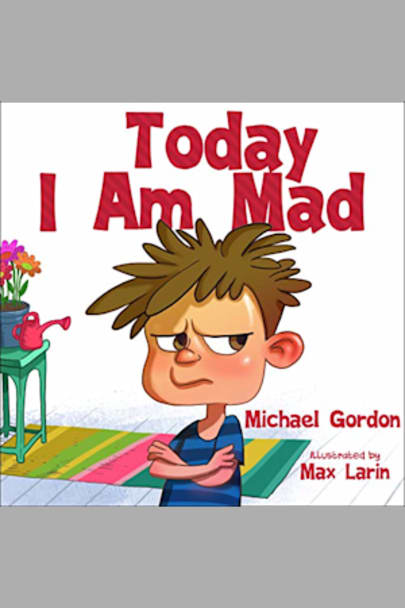Kids feel emotions in big ways! Here’s a great story for helping kids manage their feelings.
Help children learn to identify and regulate their emotions
Anger is a normal, healthy emotion.
Behaving badly doesn’t make you bad
Teaching your kids to deal with disappointment
Learn to tame your temper
Teaching kids about empathy, kindness, and compassion
It has a great message: “This is …
It has a great message:
“This is a sweet little book. My 4 year old quotes it now when he starts getting cranky. ” – Julia
“We like this book! IT’s fun, and my girls like me to read it to them every night before bed“ – Liz
Explains empathy & kindness:
“I got this book for my grandson. The pictures are colorful and the story teaches about patience. Book is perfect for the 3-5 -year old.“ – Kathy
“Cute story, emphasizes empathy & kindness. My kids loved it!” – Carol
-
And
- Cute illustrations with nice rhyming story
- Not too long, grabs kid’s attention
- Print version includes COLORING PAGES
GET IT NOW and get the ebook for FREE!! Add this amazing kids book to your cart and ENJOY!more



All praise to the a author, Michael Gordon, for showing that kids do learn the lessons that parents teach them. Josh learned his lessons well and put them into practice.
Tom was mad at play school one day. Josh had his favorite toy. He went and they had a tug-of-war fight for it. He saw it was making Josh sad. Tom stopped and asked if Josh would like to play together. Do they play? Do they fight any more? Find out with your kids. E
Today I am Mad – Michael Gordon – I have a thing for these books that give kids the emotional framework to give words to their feelings! Happy Reading!
hi
18 Pages.
Nice reading
At playschool, little Josh is angry.
Little Tom is playing with Josh’s favorite toy.
Josh wants the toy…
———————-
A nice book which shows (in several situations) the little child how to calm down…
Lovely and clear
PS : just to say that sometimes children doesn’t like “hugs”(particularly when they’re angry).
Today I am Mad by Michael Gordon has this classification on its Amazon page: Anger Management, Kid’s Books, Baby, Childrens, Ages 3 5, Emotions. So why am I reading this? There are three reasons. I like to occasionally see what materials are available for learners just starting out. I am sure all of you do also. As I watch TV feel-good shows, parents show up to discuss the importance of teaching materials young people can access. What books can parents buy for their children that are appealing and deliver a positive social message? If you (any reader out there) are serious, said concerned person must dip their toes in the pool of available resources for young people. For me, that includes books. It is not enough to look only at book covers. You might think you can judge a book by its cover or even in the first few pages. If I had done that with this book, my review would have differed from the one you see printed here. Read the books you pontificate on. (I am a contrarian about ending sentences with a preposition). So much for reason one and I can comfortably descend from my soapbox rant about people who post reviews without reading the book.
Reason two is much shorter. I received an author alert that the book was available; I had previously posted a review about another of the author’s works. Reason three is the shortest yet. For one day, the book was free. It is now USD 2.99 but can be read for free with a Kindle Unlimited membership.
I liked the page at the beginning with the “This Book Belongs To” and then space for the young owner to fill in name and other desired data. First, it probably involves the parent and gives practice in printing. Second, my young ones have a pride of ownership and knowing that something belongs to them. That does not contradict the message of sharing central to the book. Ownership and sharing of community toys are not contradictory ideas.
Pages One through Four set the scene between Josh and Tom. Although Josh initially “wins,” I like Page Five when the setting becomes somber; the weather seen through the window even seems sad. Josh and Tom play well together for a while until Josh returns home for the “cookie” incident. Then there is a chance for Josh to review his counting skills as his emotions subside. Josh learns that exercise makes him feel better. When Dad returns home, the importance of parental approval and support is illustrated.
So much for practice. Now it is time to export Josh’s skills to other societal settings. Josh returns to school, notices a conflict situation in the making, and decides to help others with hugs. This is the point where this book ends, and my disagreement starts.
I suggest that physical contact, demonstrated in this book through hugs, can be culturally inappropriate. I rejected this approach when I was as young as the huggee. I reject it at my advanced age as the hugger. This book got all the way to the last page before the hug happened. I was ready to give this a thumbs-up five Amazon star rating until the hug. For now, because I liked the illustrations, I give it four stars.
On the positive side, because this book put the hugs on the last page, there is an opportunity to expand the book with additional pages that could rescue Josh and friends from unwanted physical intimacy.
it is the best big point of buying it!!!!!!!!